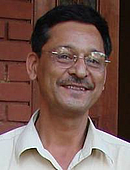JAIN VISHVA BHARATI UNIVERSITY

 The attitude of human society about violence and nonviolence is not wholesome. The world peace is also confined to the abolition of war. This is a concept that is less probable, and only little benefit to society accrues from it. Let us start our thinking on nonviolence from an individual. Every person is possessed of the consciousness of violence. On getting favourable stimulus, it gets instigated, which, in turn, has its effect on individual, family and society. Nonviolence is in fact a matter of conduct. Its philosophical aspect is Anekanta (i.e., non-absolutistic approach to truth which has many facets). Anekanta in itself is the key to the exposition of the theory of the universal principle of co-existence. Through the application of Anekanta (i.e. non-absolutism), it is easy to understand that two mutually opposite entities can exist together - co-existence is possible between them even while maintaining their own independent identity. The best illustration of this is the metaphysical substance in which all the three attributes, viz., origination, cessation and persistence, always exist together. It implies that both-that which is unchangeable and that which is changeable - can co-exist.
The attitude of human society about violence and nonviolence is not wholesome. The world peace is also confined to the abolition of war. This is a concept that is less probable, and only little benefit to society accrues from it. Let us start our thinking on nonviolence from an individual. Every person is possessed of the consciousness of violence. On getting favourable stimulus, it gets instigated, which, in turn, has its effect on individual, family and society. Nonviolence is in fact a matter of conduct. Its philosophical aspect is Anekanta (i.e., non-absolutistic approach to truth which has many facets). Anekanta in itself is the key to the exposition of the theory of the universal principle of co-existence. Through the application of Anekanta (i.e. non-absolutism), it is easy to understand that two mutually opposite entities can exist together - co-existence is possible between them even while maintaining their own independent identity. The best illustration of this is the metaphysical substance in which all the three attributes, viz., origination, cessation and persistence, always exist together. It implies that both-that which is unchangeable and that which is changeable - can co-exist.
The empirical philosophy of Anekanta furnishes the foundation for nonviolence. There are mainly five principles of this empirical philosophy of Anekanta:
- Relativity (sapekshata)
- Harmony (samanvaya)
- Reconciliation (samanjasya)
- Independence (svatantrata)
- Co-existence (saha-astitva)
If the first four, viz., relativity, harmony, reconciliation and independence are developed, then only we can have the peaceful co-existence.
Thus, no development of nonviolence is possible without Anekanta, and in turn, no peace is possible without nonviolence. We can not expect the right conduct without rectifying the attitude or vision. Hence, we have to accept the fact that nonviolence can sustain and develop only on the foundation of Anekanta and in the surroundings of Asamgraha or Aparigraha i.e., non-accumulation. It is the faulty system of economics today that is responsible for giving rise to violence and terrorism.
According to Acharya Mahaprajna the economic aspect has greatly influenced the mankind. But, the aim of the modern economics is economic prosperity and the degree of happiness that one may derive from wealth will depend on its carefully planned project. All wish that they were rich, endowed with abundance of resource, and all their needs be fulfilled but on account of their greed, craving for the acquisitions of wealth, unbridled desires and excessive use of resources it remains a dream for them. Though the modern economics is dedicated to economic development and increase in production, it has nothing to do directly with such vitally important issues as to whether someone is happy or unhappy and whether the basic values of life are being nurtured. The modern economics doesn't regard non-violence, peace and morality as important questions. That is why the world today is grappling relentlessly with the problems of violence and terrorism. In today's competitive society instead of being a source of happiness wealth has become the main cause of human unhappiness and suffering on account of economic disparities.
Violence and possessiveness are correlated and cannot be parted. The model of economic development in neo economic system is neither ethical nor non-violent, hence, wealth is proving to be the stimulant for violence. It (wealth) is being used more for destructive purposes rather than to meet the needs of life. The soil is fertile for hypocrisy in commerce industry. Lust for wealth and corruption is increasing. The compulsiveness of giant industries and business are being established at the cost of small scale and cottage industries which are being ignored and are loosing their ground, resulting in the increasing gap of rich and poor. Import of machinery is increasing and the dignity of labour is decreasing, resulting in growth of unemployment and hunger.
If economics continues to remain merely the economics of utility, it will not be possible for us to remove social disparities. If the basic human values like non-violence, peace, purity of means, self-restraint as propounded by Lord Mahavira are integrated with the modern economic principles, it will bring about a big change in societal outlook towards production, distribution and consumption. It will also result in the fulfilment of the primary needs of the poor and weaker sections of society. Lord Mahavira laid down the vow of non-possession for ascetics. He knew that it was not possible for the house-holders to refrain completely from possession, so he propounded the principle of limiting individual desires and needs. If an individual can limit his desires and needs, it will pave the way for an economically sustainable society.
There are 12 vows in the code of conduct for the laities as propounded by Mahavir, which are quite relevant in the present context may be mentioned here:
- Don't earn money through illegitimate means.
- Put a limit to your personal accumulation.
- On the basis of these two vows, decentralized economic system can be developed.
- Put a limit to your personal consumption of goods.
Gandhiji's policy was based on the trio of decentralized power, decentralized economic system and decentralized industry. Wherever the centralization of power, money and industry becomes intense, there is consequential augmentation of exploitation and violence. If that economic policy of decentralization would have been adopted in India, then the rural people would not have remained so backward and so poor today.
Three terms given by Bhagwan Mahavira are very significant:
- Curtailed desires
- Curtailed accumulation
- Curtailed violence
Pondering over these terms, we find that curtailment and decentralization both have the same implication. We cannot minimize violence, unless we curtail desires and accumulation. The thinking, that, without violence, neither life can sustain, nor the society can sustain, nor can the nation be defended, furnishes the ground for violence to grow. To resolve this contention, the classification of violence given by the great Jain Acharyas is definitely worth considering. They have classified violence into three categories - 1. Arambhaja Himsa - the violence perpetrated during agricultural or professional activities such as commerce, industry etc. 2. Virodhaja Himsa - the violence perpetrated for defence against aggression. 3. Sankalpaja Himsa - the violence perpetrated for establishing one's dominance (or sovereignty) over others or perpetrated due to the imperialistic and consumeristic tendencies.
Nonviolence has to be cultivated gradually. Only after properly understanding the limitations of Nonviolence, we can establish it in social life. As far as the development of Nonviolence in the social life is concerned, refraining from the third category of violence is imperative. It is the third type of violence (i.e., sankalpaja himsa) which is a threat to the world peace. The direction of the campaign of the Nonviolence should be to free the world from the sankalpaja himsa, in absence of which both aggressive and defensive violence would come to an end.
The first category of violence (i.e., the arambhaja himsa) is inevitable for livelihood, and therefore, only its limiting to some extent is possible, but it can not be avoided altogether. The "tit for tat" policy, i.e., violence against violence or violence against terrorism, can only be a short-term policy; it cannot be regarded as a permanent solution. What is needed, therefore, is to ponder over a long term policy of Nonviolence, and that is, the training in non-violence.
The main factors responsible for promoting violence and terrorism are believed to be - fundamentalism or fanaticism, racial or caste based conflicts, hunger for power, urge for having dominance over the market, the frenzy of anger or wrath, egotism, greed, fear, hatred, lust and criminal tendencies. We shall have to think seriously on them from philosophical and psychological view-points. As a matter of fact these are not the seeds of violence; they are rather the flowers and fruits of violence. Only through the effective training in non-violence, the seeds of violence could be rendered impotent.
Faith in Non-violenceToday the greatest crisis is that of faith. No effort is made to inculcate faith in Nonviolence in the students. In young age, the materialistic attachment naturally gets augmented and it becomes difficult to build the faith in Nonviolence in him/her. The scepticism about the utility of the eternal value for Nonviolence for the society is intensified. Today there is no provision for inculcation of the values like sensitiveness, love, friendliness, compassion etc. in education. In the human brain, there are centres related with love, compassion, etc. as well as with hatred, cruelty etc.. It is estimated that the latter centres are relatively more activated than the former ones. Such situation cannot be changed merely through verbal education like reading a moral lesson, sermonization or lecturing etc.. What is needed is a thorough training, a part of which may be lecturing, but more important or powerful step would be - anupreksha (i.e., repeated contemplation with auto-suggestion).
The anupreksha is a method of super learning in which goal achievement is made through the practices such as - sankalpa (i.e., a strong resolve), auto-suggestion, kayotsarga (a systematic practice of self awareness coupled with relaxation of the body), concentration of mind etc.. These practices bring about the transformation of consciousness not only on conscious level but also subconscious or unconscious levels. The consciousness of violence also gets transformed.
 Dr. Anil Dhar
Dr. Anil Dhar